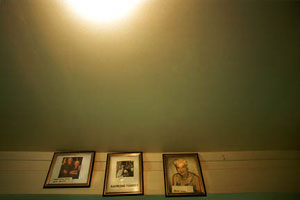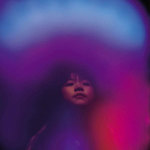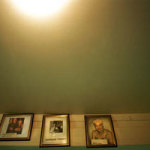Defined for this show as the "esoteric and occult side of the otherworldly", much of what is considered "spiritual" in the show creates much inquisition, but perhaps not in the manner in which it was intended. One photographer, Daniel Ranalli, uses the 19th century photography techniques of the cliché verre and the photogram to produce white ethereal Buddha figures within an environment defined by expressionistic streaks of brown toner. Ranalli's intention is to use the iconic Buddha as spiritual exemplar, based on his observations during his travels to Asia, but greater issues of exoticness and fetishism emerge. Here the Buddha is incomparably reduced to an innocuous symbol, a caricature of itself, devoid of any reverence or divine importance except as a logo for a "spiritual" product, in this case, Buddhism.
Similar questions of the exotic arise within Chrysanne Stathacos' Aura Project but her images also question photography itself. A large grid of portraits is presented, which were taken with a "specially-adapted instant camera designed to measure a person's electromagnetic energy through a hand sensor." This electromagnetic energy is said to be the person's aura. The Polaroid portraits themselves are saturated with Rothko-like swabs of luminescent color. From a distance it is an intoxicating visual. But upon inspection problems occur. A vast majority of the portraits are of exotic subjects: Indian sadhus, Tibetan monks and Asian children. Do these subjects inherently contain what, from a distance, read as spiritual? Were these portraits taken of those determined as "savage" as opposed to "spiritual", the images would look no different: objectified, distanced, regarded as a specimen of an embodied condition rather than as an individual.
What Stathacos does do brilliantly, and is a wonderful subtext of the show itself, is the challenge to "believe" what a photograph claims. She asks us to believe that people actually have auras, that they are potentially visible, they can be photographed, in luminous color and here they are. So how can we doubt this evidence?
Another photographer in the show, Bill Armstrong, presents a square photograph with a glowing white sphere surrounded by a pastel blue, stating that he has focused his camera on infinity. Are we to believe that he has recorded an image of infinity or is his image a result of the impossibility to do so? Armstrong could have accomplished this image in any number of ways on any number of subjects, but to have his viewer believe his record of evidence in terms of infinity underscores how heavily photography, like spirituality, primarily exists within the parameters of faith.
Interestingly, a small gallery in the midst of the "Concerning the Spiritual" contains historical examples of faked spirit photographs, which enjoyed prominence from the 1860s to the 1930s. By combining formal portraits with nebulous headshots floating around the subjects, photographers were able to convince a wide audience of the authenticity of the recorded "spirit." Though these photographs were ultimately discredited, they found particular appeal in a wounded public after the devastations of the Civil War and W.W.I. As we currently find ourselves in yet another wartime period, this shows seems to be asking: "You see through the facade of things, but what is it that you actually believe?"
- Unidentified photographer, Houdini and unidentified man in faked spirit photograph, circa 1920, gelatin silver print, Courtesy of the Estate of Dame Jean Conan Doyle, Photography Collection, the Harry Ransom Humanities Research Center, The University of Texas at Austin.
- Chrysanne Stathacos, 2001, from The Aura Project, 2001, Polaroid, Courtesy of the artist
- Shannon Taggart, Wall of Retired Mediums, 2003, C-Print, 21 x 30 inches, Courtesy of the artist
----
Links:
Photographic Resource Center
University of Texas Harry Ranson Center
Shannon Taggart
Houdini Historical Center
How to Create Fake Photos of Ghosts
Boston Globe review
"Concerning the Spiritual in Photography" was on display January 23 - March 14, 2004 at Boston University's Photographic Resource Center.
All images are courtesy of Boston University's Photographic Resource Center.
Ben Sloat is a regular contributor to Big, Red and Shiny.







